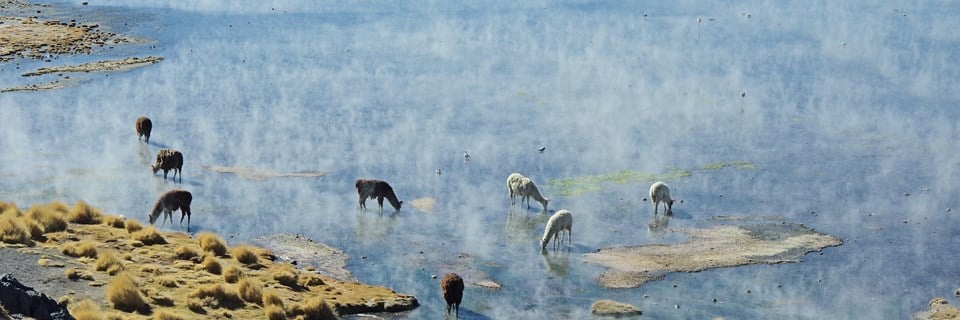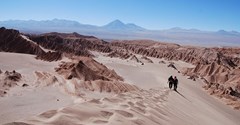Team member Chris takes an unforgettable journey to the high altitude flamingo-filled lagoons of the Bolivian Altiplano.
There was a time when all of my trips were planned around photography. I went in search of the extraordinary power and beauty of nature and sought out the hidden corners of cities where I could get the right angle on a famous sight, or discover something glossed over or excluded from guide books. But in more recent years I have learned to combine this with a desire to better experience and fully embrace the sometimes intangible sides of a destination; the local culture, the layers of history and the fascinating stories that come with them. I wanted to know and feel a place, and have photos to reflect those memories.
Journeying south through Bolivia, from Uyuni to the Atacama Desert in Chile, was therefore something of a throwback trip. Two days with little more to do than admire the astonishing landscapes, revel in the tranquillity and the beauty of it all and capture it for prosperity with my trusty Pentax as best I could. For a photo enthusiast, this was heaven.
The Lonely Road South
Having explored in detail the vast Salar de Uyuni and having left behind the melancholy train cemetery, our final contact with any sort of substantial civilization for the next couple of days came at the tiny town of San Cristóbal, where wholly llamas roam free and colourfully-dressed school children play happily in the middle of the empty road. I stocked up on dried coca leaves to aid me in my battle against the high altitude and we set forth into the unknown.
With the town in the rearview mirror, the lonely track led us through scrubby plains fringed with gracefully sloping mountainsides and then onto boulder-strewn rock valleys and eventually to the first of the shimmering mineral-rich lagoons. More than anything else, it is these which tempt travellers to venture so far off the beaten track, withstanding high altitudes, freezing nights and long bumpy drives. The reward for such endeavour is to enjoy some of the continent's most mesemerizing scenery all to yourself, a rare treat and one which affords the time and tranquillity to soak it all in and savour the moment.
The first to come into view is the brilliant white flash of Laguna Cañapa, an arresting salt lake situated 4,100 metres above sea level. Its striking beauty is enhanced infinitely by the complete lack of tourists and the dreaded sight of tour buses blighting the view; aside from my three fellow travellers and our trusty guide and driver duo Arturo and Leo, there is nothing and nobody to distract from the hauntingly beautiful scenery, immense blue skies and the handful of flamingos scattered around the few parts of the lagoon not covered in crusted salt.
At Laguna Hedionda I was far too busy snapping photos of the huge flocks of Andean flamingos just a few metres away to note whether the lagoon was, as the Spanish translation suggests, a bit stinky. It might not smell like a bed of roses, but I can barely imagine a better place to see flamingos in the wild (a view that was to be challenged at Laguna Colorada the next day).

The flamingo is an extremely graceful and fascinating creature. That it can appear so poised, even balletic, despite such a ridiculously large body compared to its spindly legs and small feet, is... well, no small feat. Yet behind the stately facade is a bird with a ferocious appetite and hunting instinct that would shame even the most feared predators. Flocks of flamingos descend on the high altitude lagoons, both here and in Northern Chile and, without standing on ceremony, set about clearing them of their nutrient-rich algae, mercilessly gobbling up mouthfuls of water and filtering out the goodness with their specially-designed bills. Once accomplished, it is on to the next unsuspecting lagoon. It is a practice which gives flamingos their distinctive pink coat and which makes for some wonderful photo opportunities as they glide across the shallow water, flying effortlessly from one section to another, one often setting off a chain reaction of take-offs among fellow diners.
The third and final lagoon of day one is probably the smallest and perhaps the most beautiful of the three. Laguna Honda is a marvel of simple beauty, hidden far from the prying eyes of all but the most intrepid travellers who have bounced and bumped their way across non-existent roads, shunning the temptation to take the express route from Uyuni to San Pedro de Atacama.
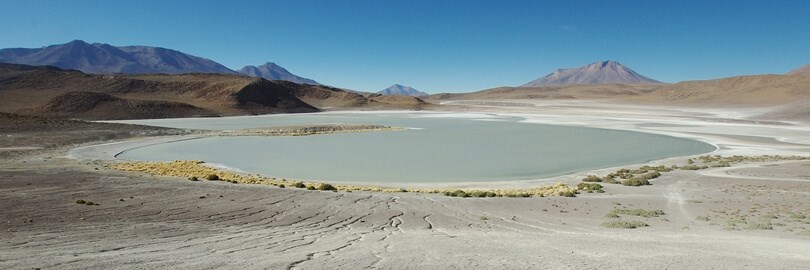
Our hotel for the night appears like an oasis in a desert, a collection of distant buildings harbouring the promise of shelter from the cold nights. As we settle into the Hotel del Desierto, the practicalities of running such an operation in the middle of nowhere begin to dawn on me. Where do all the staff live? What happens when they run out of milk? How did Leo even find it with so few reference points? As much as I wanted to ponder these questions or seek answers from Arturo, I instead flopped into bed and spent the night cooped under thick blankets and fighting a losing battle with the rarefied night air, which wastes little time in drying out your mouth just seconds after each gulp of bottled water.
It was a long night.
The Stone Tree
Since heading out into the great white expanse of the Uyuni Salt Flat, it had been hard to recall seeing many trees - those ever-present pillars of daily life that we perhaps too readily take for granted. The closest I had got were the cacti of Isla de los Pescadores.
When travelling it is often much harder to notice the things that aren't there, particularly something so mundane as a tree, rather than, let's say, those distant guanacos dotting the horizon, or the looming presence of mysterious Andean mountain ranges. It wasn't until our first port of call for the day was announced that I looked left, looked right and wondered where indeed had all the trees gone. There were so many back on the shores of Lake Titicaca.
Of course, El Árbol de Piedra is no ordinary tree though, this is a lone wolf in the remote Bolivian Altiplano. Like any good tree, it is reassuringly old, having withstood the test of time and with the battle scars to prove it. It is however, a tree in full bloom - not a sad empty branch in sight, even as we exit winter and head towards the promise of spring - and its bark is thick and sturdy, all the better so support the weight which sits heavy above it. All things considered, this is a pretty good tree then, even more so when you consider that it consists of nothing but rain-beaten, wind-battered stone, eroded over hundreds of years in the solitude of the Siloli Desert.
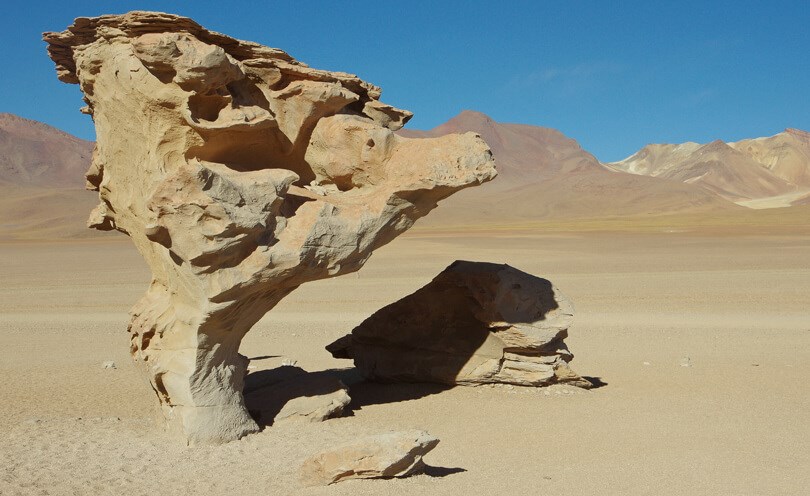
We pushed on further, deeper into the snappily-named Reserva Nacional de Fauna Andina Eduardo Avarea, until we reach one of the most beautiful sights a pair of human eyes (or a Pentax K3 lens) could ever wish to lay themselves upon.
The Red Lagoon
The Laguna Colorada is, in every sense of the word, simply breathtaking. At 4,278 metres above sea level, if the altitude isn't enough to stop you in your tracks then this splash of red will do so without fail. It's as if God wasn't satified with yet another sparkling lagoon and so, in a moment of inspiration, infused it with an injection of crimson and beckoned forth flocks of vibrant flamingos and a herd of wandering llamas. As I watched great plumes of steam rise majestically from the depths of the water, engulfing the thirsty llamas, there certainly seemed a biblical sense to it all. I failed hopelessly to sum it up in anything other than repeated utterances of "it's so beautiful" and affirming that I hadn't ever seen anything like this before. I zoomed the camera to capture the wildlife up close, zoomed out to frame the lagoon at the foot of the mountains and broke out my wide angle lens to get it all one frame, all in the hope of capturing some essence of the splendor of this remarkable place.
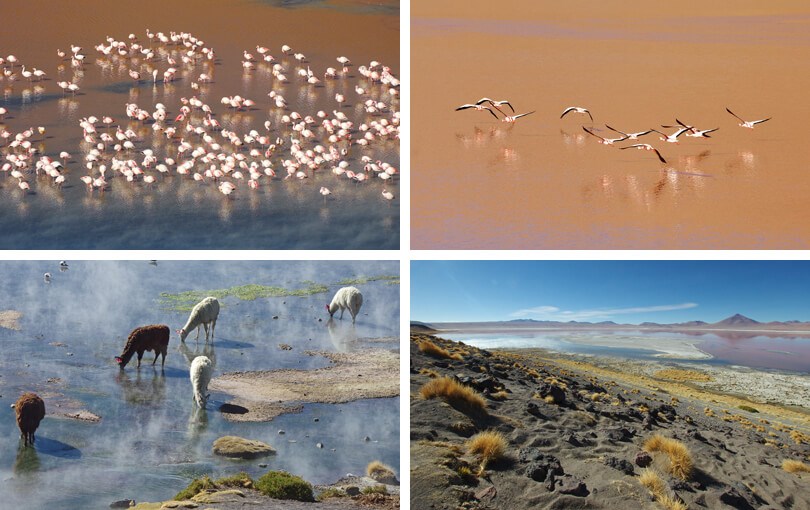
The Angry Monster
We crossed paths with some lonely vicuñas and a hardy (human) soul pedaling wearily across the barren landscape, presumably with a decent puncture repair kit stowed away somewhere. This is no place for a flat tyre. And then, all of a sudden, a huge plume of silvery steam came into view, billowing furiously into the cloudless skies - we'd reached Sol de Mañana (Morning Sun).
If Laguna Colorada was sublime, this was downright bizarre at first viewing, yet equally astonishing in its own way. We were now stood atop a vast geothermal field, alive with volcanic activity, 4,900 metres above sea level. Small spouts of steam escaped holes in the earth and bubbling mud pools spat out warning shots, one of them landing on the leg of a fellow traveller. But these were all a prelude to the centre-piece - a towering plume of vapour that reaches heights of 50 metres and changes direction at the drop of a hat. Without warning, it lowered itself, rotated round and came hurtling my way, engulfing me in a disorienting (yet ultimately harmless) cloud. A pungent stench of sulphur hung in the air and despite the evocative name, this isn't a place that embraces the tourists that crosses its path.
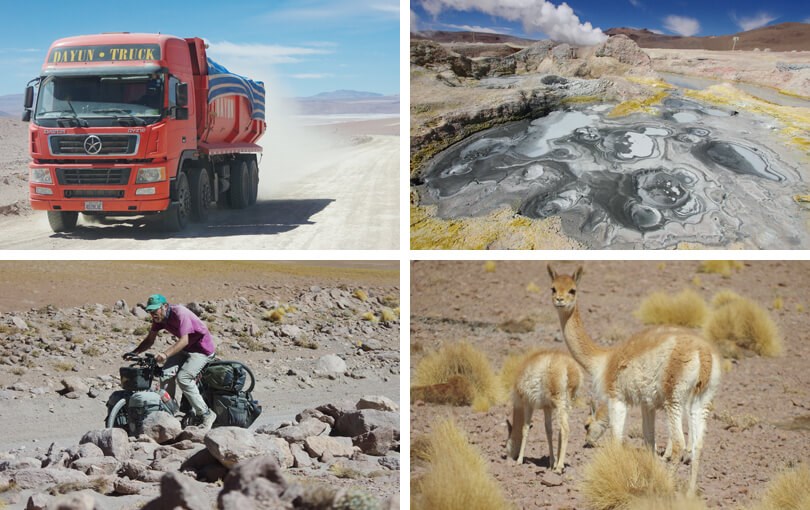
The Sad Farewell
The Chilean border was getting ever closer and with it the time we had to leave Bolivia behind and bid farewell to a country I had been utterly charmed by over the past few days. At this point though, it was the remarkable scenery that was still holding my attention most as we bounced past mountains painted with ever more daring palettes, from the undulating 'distressed rust' look, to the 'mustard yellow-cum-merlot' effect which scythed down dramtically behind Laguna Blanca.
In the distance I spied what appeared to be the top of Volcan Uturunca peeking out between the hills, if not it's a dead ringer for the one pictured in our locally-produced leaflet explaining the highlights of the reserve. The volcano is apparently the highest mountain in Southern Bolivia, measuring in at a lofty 6,028 metres - perfect therefore for 'escalating practices'.
Having skirted around the Salar de Chalviri, little brother to the mighty Uyuni Salt Flat last seen two days ago, we stopped briefly at the Desierto Dali, a lunar-like landscape so named because it wouldn't look out of place in one of those surreal masterpieces of Salvador Dali. A few oddly-shaped rocks are scattered here and there, but I'm not entirely sure where to find the melting clocks, the ghostly abandoned car or the enormous butterflies.
We pushed on, now dangerously close to running out of Bolivia in which to explore. There were precious few lagoons left to marvel at and no more other-worldly and downright bizarre natural phenomenons to boggle our oxygen-starved minds, not until we crossed into Chile. So we had to really savour the last two lagoons, interlinked and spread out at the foot of Volcan Licancabur, the 6,000 metre high mammoth which marks the border, adorning postcards on both sides of the divide.
Laguna Verde is the star of the show, its turquoise, rather than green, water shimmering seductively in complete contrast to the muted tones of the volcano. It was as if someone had left it here as a sort of thank you for visiting sign or a parting gift from the hosts. Or perhaps not, maybe its real purpose was to welcome visitors coming in the opposite direction - welcome to Bolivia, look what we can do.
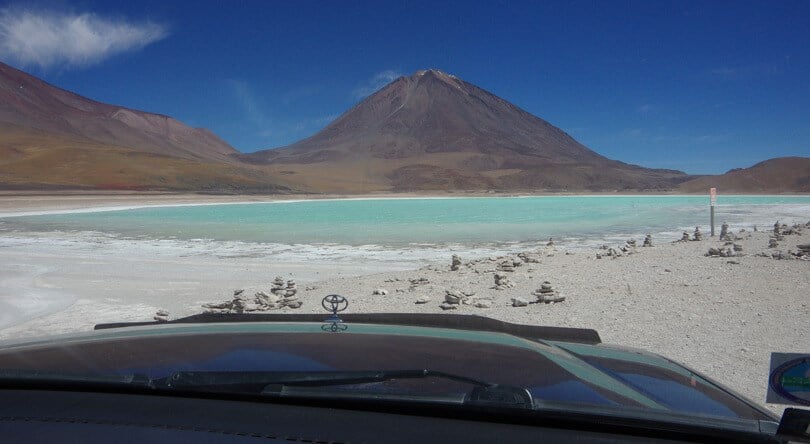
And so, after a somewhat subdued lunch, it was a sad goodbye to Arturo and Leo, our travelling companions over three unforgettable days, and their trusty Toyota Landcruiser, that hadn't once threatened to let us down. Given the political history between Bolivia and Chile (see Pacific War), it's no real surprise that the two borders are separated here by a 45 minute drive (as opposed to a 45 second walk from Peru to Bolivia). In truth and if you'll excuse the pun, it took a little while for me to warm to Chile, but then anything was going to be a hard act to follow after Bolivia, when it was amor a primera vista.
Choose your perfect holiday
Find inspiration from our selection of itinerary suggestions, a great starting point for your next trip
View More Tours
Stay in touch
Infuse your travels, with inspiration from our monthly newsletter.
READY - 20 April 2024
LANDMARK TOURS: Multi-Country & Cross Continent. New Cosmopolitan Tour: Buenos Aires, Iguazu, Rio
CHINA & INDIA: Local Life, People & Unique Cultures
GUIDES by Veloso Tours, are the best Local Hosts
PRIVATE VILLAS: Quality Time in exclusive settings
TRAVEL INSURANCE with extensive COVID-19 cover
